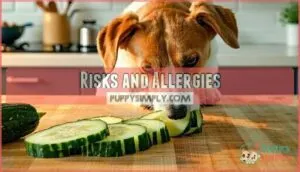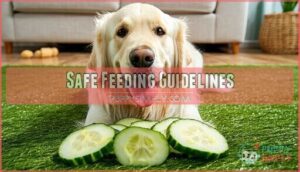This site is supported by our readers. We may earn a commission, at no cost to you, if you purchase through links.

The tough, waxy skin can cause digestive upset and potentially lead to intestinal blockages, especially in smaller dogs.
While cucumber peels aren’t toxic, they’re difficult to digest and can trigger stomach problems like vomiting or diarrhea.
Instead, peel the cucumber and offer small, bite-sized pieces of the cool flesh as an occasional treat. Your pup will still get the hydrating benefits and vitamins without the risks.
There’s more to know about proper preparation and serving sizes.
Table Of Contents
- Key Takeaways
- Cucumber Peel Nutrition
- Can Dogs Eat Peel
- Health Benefits Explained
- Risks and Allergies
- Preparation and Serving
- Safe Feeding Guidelines
- Frequently Asked Questions (FAQs)
- Can dogs eat cucumber skin?
- Is it safe to give cucumber peels to dogs?
- Can dogs eat cucumber seeds?
- Can puppies eat cucumber?
- Can dogs eat pickles?
- Can dogs eat cucumber water?
- Why can’t dogs have cucumbers?
- How much cucumber can I give a dog?
- Will cucumber upset my dog’s stomach?
- Can puppies eat cucumber peel safely?
- Conclusion
Key Takeaways
- Always peel cucumbers before giving them to your dog, since the tough skin can cause digestive upset or blockages, especially in small dogs.
- The flesh of cucumber is safe, hydrating, and packed with nutrients, making it a great occasional treat for your pup.
- If you decide to feed cucumber peel, wash it thoroughly, cut it into tiny pieces, and introduce it slowly to watch for any stomach issues.
- Never let treats like cucumber exceed 10% of your dog’s daily calories, and always check with your vet before adding new foods to your dog’s daily diet.
Cucumber Peel Nutrition
You’ve probably wondered whether your dog can safely munch on cucumber peels while you’re prepping this cool veggie.
The peel actually packs more nutrients than the flesh itself, containing concentrated vitamins, minerals, and beneficial compounds that can support your pup’s health.
Nature’s superfood for your pup—cucumber peel delivers maximum nutrition in every bite.
Antioxidant Properties
Cucumber peels pack powerful antioxidants like flavonoids (apigenin, quercetin) and polyphenols that fight free radicals in your dog’s body.
Nature’s antioxidant powerhouse fights aging from the inside out, giving your pup cellular protection with every crunchy bite.
These compounds provide cellular protection against oxidative stress, potentially slowing aging processes. The antioxidant benefits help neutralize harmful molecules that damage cells over time.
Your pup’s immune system gets natural support from these protective compounds found concentrated in the peel, offering a form of cellular protection.
Vitamin Content
Beyond their impressive water content, cucumber peels pack essential vitamins that benefit your furry friend’s health.
The skin contains concentrated nutrients that make cucumber peel safe for dogs when properly prepared.
Key vitamins in cucumber peel include:
- Vitamin C – Supports immune function and acts as a natural antioxidant, helping your dog’s body fight free radicals
- Vitamin K – Essential for proper blood clotting and bone health, making cucumber benefits dogs particularly valuable for active pups
- Folate Content – Aids in DNA synthesis and red blood cell formation, supporting overall cellular health
These cucumber Vitamin C and cucumber Vitamin K levels work together to enhance nutrient absorption while maintaining proper mineral balance.
The dog cucumber nutritional benefits become especially apparent when you consider how these vitamins support your pet’s natural healing processes and energy metabolism.
Mineral Composition
Looking at cucumber peel’s mineral composition, you’ll find a treasure trove of essential nutrients for your dog’s health.
This natural coating packs potassium content that supports heart function, while magnesium benefits muscle and nerve health.
Silica role includes strengthening bones and joints, making cucumber peel safe as an occasional treat.
| Mineral | Key Benefits |
|---|---|
| Potassium | Supports heart rhythm and muscle function |
| Magnesium | Aids nerve transmission and bone health |
| Silica | Strengthens connective tissues and joints |
| Calcium | Maintains strong bones and teeth |
The manganese effects include supporting metabolism and antioxidant function, while calcium levels contribute to skeletal strength in growing pups.
Hydration Benefits
The 95% water content in cucumber peel makes it nature’s hydration booster for your dog.
This natural fluid balance support helps prevent dehydration, especially during summer safety concerns when dogs need extra hydration tips.
Think of cucumber water as a low-calorie treat that doubles as dog hydration therapy—perfect for maintaining ideal health year-round.
Can Dogs Eat Peel
Your dog can safely eat cucumber peel when prepared properly. Most veterinarians consider cucumber peel safe for canine consumption in small amounts, making it a healthy addition to your pet’s diet.
The peel contains valuable nutrients like dietary fiber, vitamins K and C, and antioxidants that support your dog’s overall health. However, peel safety depends on proper preparation.
Always wash cucumbers thoroughly to remove pesticide residues and contaminants before serving. Organic cucumbers are your best bet for minimizing chemical exposure. Cut the peel into small, manageable pieces to prevent choking hazards, especially for smaller dogs.
While cucumber peels aren’t toxic, remember that banana peels aren’t safe for dogs. While generally safe, some dogs may experience mild digestive upset from cucumber peel due to its higher fiber content.
Dogs with sensitive stomachs should be introduced to cucumber peel gradually. The peel contains cucurbitacin, a naturally occurring compound that can cause gastrointestinal irritation in sensitive dogs, though this is uncommon with proper portion control.
Health Benefits Explained
Now that you’ve learned cucumber peel is safe for dogs, let’s explore the specific health benefits it offers your furry friend.
The peel contains concentrated nutrients that can support your dog’s overall wellness when fed appropriately, which can lead to improved health outcomes, making it a valuable addition to their diet with overall wellness.
Anti-Inflammatory Effects
Cucumber peel offers powerful anti-inflammatory benefits for your pup.
The peel contains fisetin, a flavonoid that blocks COX-2 enzymes, reducing inflammation and supporting anti-aging processes.
Antioxidants like kaempferol combat oxidative stress throughout your dog’s body.
Here’s how cucumber peel fights inflammation:
- Fisetin Benefits – This compound directly inhibits inflammatory pathways while promoting cellular repair
- Antioxidant Protection – Flavonoids neutralize free radicals that trigger chronic inflammation
- COX Inhibition – Natural compounds reduce enzyme activity linked to joint pain and swelling
These antiinflammatory properties make cucumbers particularly beneficial for older dogs experiencing age-related inflammation.
Cancer Prevention
Beyond reducing inflammation, cucumber peel offers powerful cancer-fighting compounds.
The lignans, fisetin, and other antioxidants work together to protect your dog’s cells from damage that could lead to cancer. These compounds help control free radicals and support your pup’s natural defense systems against harmful cellular changes.
| Cancer-Fighting Compound | How It Helps Your Dog |
|---|---|
| Lignans | Block estrogen-based cancer pathways and support tumor suppression |
| Fisetin | Provides antioxidant defense and carcinogen inhibition through COX-2 blocking |
| Cucurbitacin B |
Offers cell regeneration support and free radical control.
Research shows cucumber and cancer prevention go hand-in-hand through these natural compounds. The antioxidants in cucumber peel create a protective shield around your dog’s cells, while dog cancer prevention benefits from the peel’s concentrated nutrients that support healthy cell regeneration.
Digestive Health
When properly prepared, cucumber peel supports your dog’s digestive health through its fiber content and natural enzymes.
The soluble fiber helps regulate bowel movements and promotes healthy gut balance, while the peel’s nutrients aid in nutrient absorption throughout the digestive tract.
- Gut Balance: Fiber in cucumber peel feeds beneficial bacteria, supporting your dog’s microbiome
- Fiber Intake: Provides gentle, digestible fiber that won’t overwhelm sensitive stomachs
- Stomach Issues: May help settle minor digestive upset when given in appropriate portions
- Bowel Movement: Regular fiber intake promotes consistent, healthy elimination patterns
Immune System Support
Through careful nutritional design, cucumber peel delivers an Antioxidant Boost that strengthens your dog’s Immune Response.
The vitamin C and antioxidants work together to support Oxidative Balance, while the fiber promotes a Healthy Gut – your pup’s first line of defense.
This Inflammation Reduction helps maintain ideal immune system function, making cucumber peel a smart addition for digestive health and overall wellness.
A well-planned diet that includes puppy immune boosters can substantially enhance your dog’s overall health and resilience.
Risks and Allergies
While cucumber peel is generally safe for dogs, you should be aware of potential risks that could affect your pup’s health.
Some dogs may experience digestive upset or allergic reactions, and the peel contains higher levels of cucurbitacin than the flesh, which is a key consideration for cucurbitacin levels.
Intestinal Blockages
Large cucumber pieces can cause intestinal blockage, especially in smaller dogs.
Whole peels or chunks may lodge in your pup’s digestive tract, creating dangerous obstructions that require emergency surgery.
Watch for blockage symptoms like vomiting, loss of appetite, and straining during bowel movements.
These digestive risks make proper preparation essential for gut health.
Cucurbitacin Toxicity
Occasionally, cucumber peel contains cucurbitacin, a bitter compound that’s toxic to dogs.
This naturally occurring toxin causes severe gastrointestinal upset, including vomiting and diarrhea. Commercial cucumbers rarely contain dangerous levels, but home-grown varieties pose higher risks.
Always taste-test first – if the peel tastes bitter, don’t feed it to your dog, as cucumber toxicity dogs can experience requires immediate veterinary attention.
For more information on safe cucumber dog snacks, consult reputable sources before making a decision to ensure safe and healthy choices for your pet.
Allergic Reactions
Some dogs develop allergic reactions to cucumber skin despite its general safety.
Food allergies and canine hypersensitivity can manifest as skin irritation, itching, or gastrointestinal upset.
Watch for allergic symptoms like excessive scratching, redness, or swelling after introducing cucumber peel. Reaction signs typically appear within hours of consumption, requiring immediate removal from your dog’s diet.
Identifying the specific allergen through a dog allergy test can help determine the best course of action for your pet’s health and identify the cause of allergic reactions to cucumber skin, which may involve canine hypersensitivity or skin irritation.
Digestive Upset
Beyond obvious allergic reactions, cucumber peel can trigger stomach issues in sensitive dogs.
Even small amounts may cause gut health problems, leading to uncomfortable bowel movements and digestive distress.
- Diarrhea causes include too much fiber from peels overwhelming your dog’s system
- Dog cucumber vomiting often occurs when pieces are too large or eaten too quickly
- Dog cucumber intestinal blockage risks increase with large peel chunks in smaller breeds
Preparation and Serving
Properly preparing cucumbers guarantees your dog gets maximum nutrition while minimizing potential risks.
You’ll need to wash thoroughly, slice appropriately, and control portions to keep your furry friend safe and healthy.
Washing and Slicing
Proper cucumber cleaning and dog cucumber preparation starts with thorough washing methods to remove pesticides and wax coatings. Rinse cucumbers under cold running water, scrubbing gently with your hands or a vegetable brush to eliminate surface contaminants.
When bathing your dog, considering sensitive skin issues is vital for their overall health and well-being.
| Washing Step | Method | Purpose |
|---|---|---|
| Initial Rinse | Cold running water | Remove dirt and debris |
| Scrubbing | Gentle brush or hands | Eliminate wax and pesticides |
| Final Rinse | Clean water | Confirm complete cucumber cleaning |
| Drying | Pat with clean towel | Prepare for slicing |
| Storage | Refrigerate if not using | Maintain freshness |
When slicing, use proper chopping techniques to prevent cucumber choking hazards. Cut cucumbers into thin rounds, maintaining consistent slice thickness of ¼-inch. This size guarantees your dog can safely chew and digest the cucumber skin without risk of intestinal blockage.
Removing Seeds and Skin
You’ll want to evaluate whether removing cucumber seeds and skin makes sense for your dog’s digestive safety.
While cucumber skin contains valuable nutrients, some dogs struggle with digestion, and seeds can pose choking hazards or cause intestinal obstruction in smaller breeds.
- Seed Removal Tips: Slice cucumbers lengthwise and scrape out seeds with a spoon to prevent choking hazard risks
- Skin Health: Keep peel on for maximum nutrients, but remove if your dog has sensitive digestion
- Digestive Safety: Monitor your dog’s reaction to cucumber skin – some tolerate it better than others
- Peel Preparation: Wash thoroughly to remove wax and pesticides before deciding on dog cucumber skin safety
When preparing cucumbers, understanding dog food peel options is vital for their overall health.
Portion Control
When offering cucumber peel to your dog, follow the 10% treat rule for Daily Allowance—treats shouldn’t exceed 10% of their Caloric Intake.
Serving Sizes depend on your dog’s weight: small dogs need tiny pieces to prevent choking hazards, while larger breeds can handle bigger portions.
Always consider Dietary Restrictions and monitor for digestive issues when introducing this low-calorie snack. To guarantee a healthy balance in your dog’s diet, make certain to understand proper dog treat portions.
Safe Feeding Guidelines
While cucumber peel is generally safe for dogs to eat in small amounts, you’ll want to monitor your pup’s reaction when introducing it to their diet.
Proper preparation and portion control help minimize potential digestive issues and guarantee your dog enjoys this nutritious treat safely, with proper preparation being key to a positive experience.
Monitoring Health
Vigilance becomes your best ally when introducing cucumber peel to your dog’s diet. Watch for changes in stool consistency, appetite, and behavior within 24 hours of feeding.
Key monitoring priorities:
- Stool consistency – Look for loose stools or digestive upset indicating intolerance
- Allergic reactions – Watch for skin irritation, swelling, or respiratory distress
- Hydration levels – Monitor increased urination from high water content
- Behavioral changes – Note decreased appetite, lethargy, or discomfort
- Blood in stool – Seek immediate vet advice if present
Regular health checks help track your dog’s response to dietary changes while ensuring proper nutrition balance and wellness.
Avoiding Overconsumption
Daily limits matter when feeding cucumber peel to dogs.
Follow the 10% treat rule – treats shouldn’t exceed 10% of your dog’s daily caloric intake. Small dogs need tiny portions, while larger breeds can handle more.
Watch for digestive issues like vomiting or diarrhea if you’ve been too generous. Proper portion sizes prevent stomach upset and maintain balanced nutrition for ideal dog cucumber health, following the key principle of daily limits.
Combining With Other Foods
You can mix cucumber peels with safe fruits like watermelon or blueberries to create nutrient blends that dogs love.
These fruit combinations work well as food toppers or frozen treats. Try simple dog cucumber recipes like peanut butter-stuffed slices or cucumber watermelon ice cubes.
These healthy snacks provide variety while maintaining nutritional balance in your pup’s diet. Many dog owners rely on cucumber dog products to supplement their pet’s meals with healthy snacks.
Consulting a Veterinarian
Before introducing cucumber peel to your dog’s diet, schedule a vet consultation to discuss your pet’s specific health needs.
Your veterinarian can provide personalized veterinary advice about dog health and pet nutrition, especially if your pup has existing digestive issues or allergies.
They’ll assess potential dog cucumber choking hazards and recommend safe portion sizes for ideal animal care.
Frequently Asked Questions (FAQs)
Can dogs eat cucumber skin?
Dogs can safely eat cucumber skin in small amounts.
The peel contains vitamins K and C, plus antioxidants that support immune function.
However, remove it if your dog has a sensitive stomach, as peels may cause digestive upset in some dogs, which can be a significant issue for immune function.
Is it safe to give cucumber peels to dogs?
Yes, cucumber peels are safe for dogs when properly prepared. You’ll want to wash them thoroughly and cut into small pieces to prevent choking hazards and digestive upset.
Can dogs eat cucumber seeds?
Those tiny cucumber treasures won’t harm your pup, but they’re not exactly stomach-friendly either.
While cucumber seeds aren’t toxic, they can cause digestive upset in sensitive dogs.
You’ll want to remove them for easier digestion, especially with puppies.
Can puppies eat cucumber?
Puppies can safely eat cucumber when prepared properly.
You’ll need to wash thoroughly, remove seeds and peel, then slice into tiny pieces to prevent choking hazards in their developing digestive systems.
Can dogs eat pickles?
Better safe than sorry – avoid giving dogs pickles due to high sodium content and toxic seasonings like garlic and onion that can cause vomiting, diarrhea, or seizures.
Can dogs eat cucumber water?
Dogs can drink cucumber water, but you’ll want to make it yourself.
Store-bought versions often contain xylitol, which is toxic to dogs.
Simply add cucumber slices to your dog’s water bowl for safe hydration.
Why can’t dogs have cucumbers?
Dogs can eat cucumbers, they’re actually safe and healthy treats.
However, you should remove seeds and peel, cut into small pieces, and feed in moderation to prevent choking or digestive upset.
How much cucumber can I give a dog?
Portion sizes vary by dog size: give 1-2 slices for extra-small dogs, up to a large handful for extra-large dogs.
Each slice should be 1 inch wide and ¼-inch thick to prevent choking hazards.
Will cucumber upset my dog’s stomach?
Cucumbers won’t typically upset your dog’s stomach when given in moderation.
However, some dogs with sensitive digestion may experience mild stomach upset, especially if they’re eating cucumber for the first time.
Can puppies eat cucumber peel safely?
Yes, puppies can safely eat cucumber peel when you prepare it properly.
Remove any wax coating by washing thoroughly, then cut into tiny pieces to prevent choking.
Introduce gradually to avoid digestive upset.
Conclusion
Honestly, your dog’s digestive system wasn’t built to handle those tough cucumber peels, no matter how much they beg with those irresistible puppy eyes.
Skip the peel entirely when offering cucumber treats to avoid potential blockages or stomach upset.
The flesh provides all the hydration and nutrients your pup needs without the risks.
Can dogs eat cucumber peel? The answer remains a firm no for their safety and comfort.












